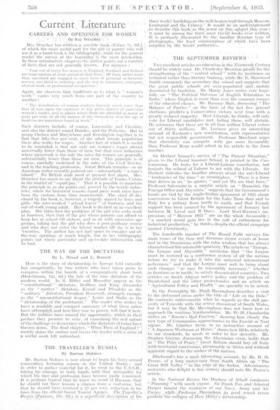Current Literature
CAREERS AND OPENINGS FOR WOMEN
By Ray Strachey • ... . Mrs. Strachey has .writtenta sensible book. (Faber, is. 6.d.), of which the most useful, part for the girl or parent who will use it as a hand-book is the bibliography, while for the general reader the' survey- at. the beginnhig is. the most. interesting. In these introductory chapters the author points out a number of facts that are not generally known. For instance : • •
" Four out of evert' five women in-England, Scotland and Ireland are wage earners at some period of their lives: Of these rather more titan one-third are engaged- in some form of personal or domestic service, one-third in indastry, and the rest in commerce, transport, clerical work, or professiohal occupations."
Again, she observes that traditions as to what is " woman's work " varies very much front one part of the country to another :
" The distribution o f women workers depends much, more than that of men upon the existence in nny given district of particular women's trades, and in places where these are plentiful .as many a, sixty per cent. of all the. woinen of the community over the age ca
fourteen are sometimes found at work." • • •
Such districts include, of course; Lancashire and Cheshire. and also the diStrict round Dundee, and the Potteries.' But to group Chelsea and Marylebone and Kensington together is to find that fifty-five- per cent, of the adult female population there also works for wages. • Another fact of which-it is useful to be reminded, is that not only are women's wages almost universally lower-than those of inen;• but that even industries where piecework is the rule the rates for women are generally subgtantially !Oliver than'•those for Men. • This principle is of course, carefully enshrined in the rules of the Civil SerVice, and in the teaching profes.sion.. • Great Britain remains—as an American writer recently pointeduut-7-substant•ially " a man's island." NO British male need at present feel alarm. Mrs.
Strachey has Much to about the attitude of Trades Unions in the matter of " equal pay." That it is possible to maintain the principle is, as she points out, proved by the textile indus- tries, where for historical reasons equal piece work rates have been the custom from time immemorial. The chief ill dis-
closed the book is, howeVer, a tragedy shared by boys and girls—the over-worked " school leaver " of fourteen, and the out-Of-Work young adult. Her book is divided on an excellent plan. She takes first the problems of the girl who seeks work at fourteen, then that of the girl whose parents can afford to keep her at school till sixteen, and so on with successive age groups, taking last the girl who does a post-graduate course and who does not enter the labour market till she is in her 'twenties. The author has not had space' to' onsider out-of- the-way openings at much length, but in her bibliegraphy points out where particular and up-to-date information can be Ilia
•






































 Previous page
Previous page